
Rocky Balboa in Philadelphia
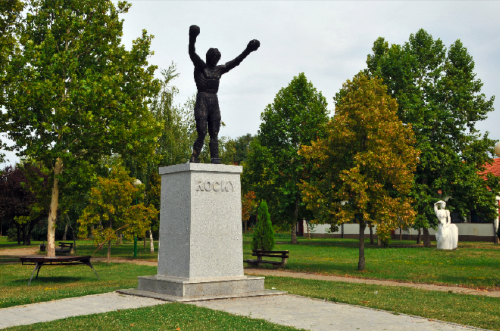
Rocky Balboa in Žitište, Serbia
The village of ŽitiÅ¡te in Serbia has repeatedly suffered heavy flooding, gaining a disaster-prone reputation. Fed up, the locals decided to erect a statue similar to the pre-existing monument in Philadelphia, PA, of Rocky Balboa, a boxer played by Sylvester Stallone in the film classic Rocky. The sculpture was to revive the village’s reputation and economic state, as it is one of the poorest cities in northern Serbia. Initiated by the Citizens Association Rocky Balboa ŽitiÅ¡te, a three-meter-high statue was revealed on August 18, 2007 in the village center.
Cameraman Bojan MarÄeta, a 28-year-old who both came up with the idea and raised the money to commission the statue, explained the impetus behind the figure chosen. “Nobody from the wars of the 1990s or from the former Yugoslavia deserves a monument, because all our leaders did was to prevent us from progressing,” said MarÄeta, “My generation can’t find role models so we have to look elsewhere. Hollywood can provide an answer.”
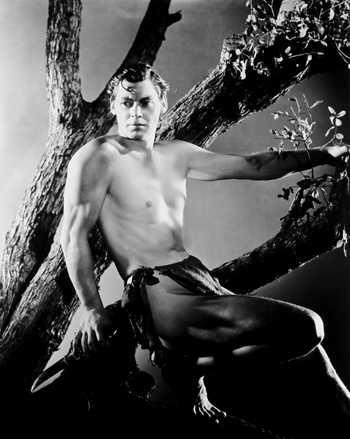
Johnny Weissmuller as Tarzan
On February 27, 2007, the village of MeÄ‘a — located on the Serbian border of Romania — announced they would build a monument to Johnny Weissmuller. Born in MeÄ‘a in 1904, and known for his role of Tarzan, residents said their choice to commission a statue of Weissmuller was inspired by the announcement of the Rocky monument in ŽitiÅ¡te. Dragan Pusara, an assistant to the mayor, told reporters Tarzan was a fitting icon for Serbs because he began with nothing, but managed to survive the jungle against all odds. Tarzan, he added, would transcend the ethnic divisions of MeÄ‘a – home to Serbs, Hungarians and Serbs of German descent – because he belongs to everyone. “After World War II, hundreds of displaced people arrived here with their families and one piece of luggage, and they needed to be strong to survive just like Tarzan,” he said.
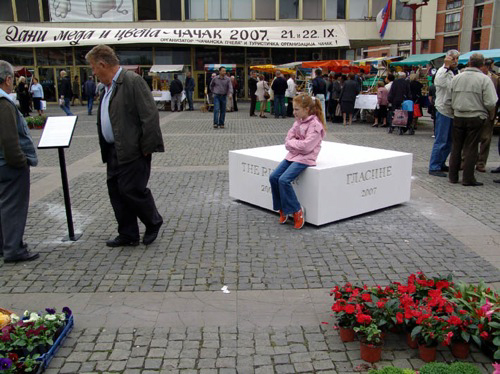
The Rumor (Or How Samantha Fox Helped Cacak Reach Fame), 2007, by Michael Blum
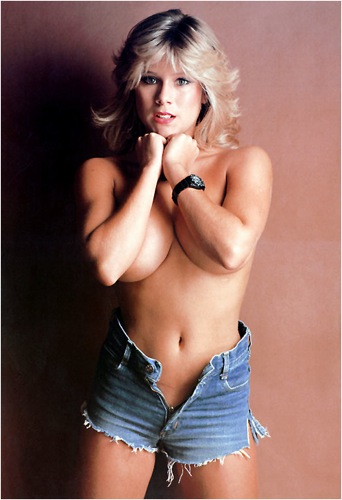
Samantha Fox
After singer and former pin-up model Samantha Fox agreed to perform at the 2007 Dani Estrade Awards in the Serbian city of ÄŒaÄak, plans were underway to erect a statue in her honor. Due to offensive remarks made by the public during the concert, the crowd jeering “Show us your tits!”, Fox failed to show up for the dinner given in her honor by politician Velimir Ilić and the monument project was subsequently dropped. Officials boasted that the statue would be larger than Rocky, but so far the only sign of Fox’s likeness is an empty pedestal with the word “rumors” written on it.
Israeli artist Michael Blum made this story a subject of his project The Rumor (Or How Samantha Fox Helped ÄŒaÄak Reach Fame) [pictured above] with an empty plinth standing for the possible sculpture in front of the Nenežda Pertović gallery in ÄŒaÄak.

Bob Marley monument in Ocho Rios, Jamaica
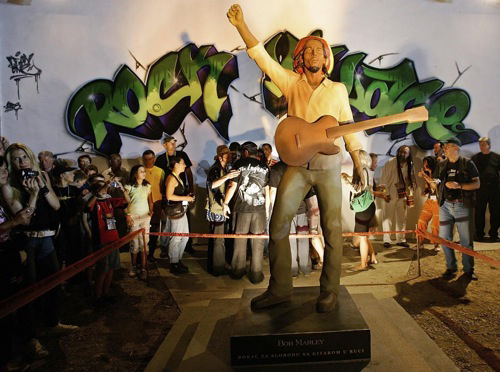
Bob Marley statue in Banatski Sokolac, Serbia
The Turbo-sculpture trend continued with the statue of Bob Marley, uncovered on August 23, 2007, during the music festival Rock Village in Banatski Sokolac, Serbia. In a conciliatory symbolic gesture, both Croatian and Serbian musicians were on hand for the event; Croatian rock star Dado Topić and Serbian musician Jovan Matić together unveiled the statue. “Bob Marley promoted peace and tolerance in his music,” explained the event organizers.
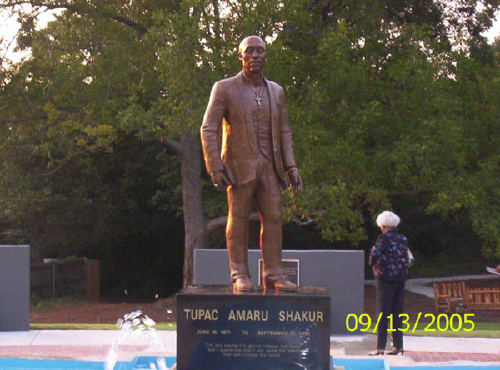
Tupac statue in Stone Mountain, Atlanta
By the end of 2008 a new building initiative for a monument to the hip-hop icon Tupac Shakur was raised by the Belgrade youth organization Rad i vizija (Work and Vision). Rappers gathered around the hip-hop forum Rad I Vizija to discuss the best place to honor Tupac Shakur. So far Marinkova Bara, one of Belgrade’s poorest neighborhoods, is favored because, as Rad I Vizija notes, “there’s no place in Belgrade that looks more like a ghetto than this.” The Belgrade suburb is predominately inhabited by gypsies. According to monument planners, the area where the statue will be mounted is poorly lit and considered unsafe. This is meant to highlight the inferior position of the Roma people and set a role model for socially deprived youth.
The initiative calls to mind a project by Italian artist Paolo Chiasera, who launched his Tupac Project on the Internet encouraging discussion among the hip-hop and web community. He then constructed a life-size statue of Tupac on top of a pedestal about 5 meters tall for the exhibition “(my private) Heroes.” Permanently positioned outside the Gehry-designed museum MARTa Herford, the monochrome statue not only signifies a crossover between hip-hop and art, but acts as a monument to the decline of monuments. Following the exhibition in Herford, the Tupac Monument lost its monumentality when the artist set it in a concrete wall marking Bologna’s most well known meeting place for hip-hop fans. As there are four Tupac statues produced by Chiasera, a possible new home for one of them is Marinkova Bara. The artist expressed interest when informed about the Serbian initiative.
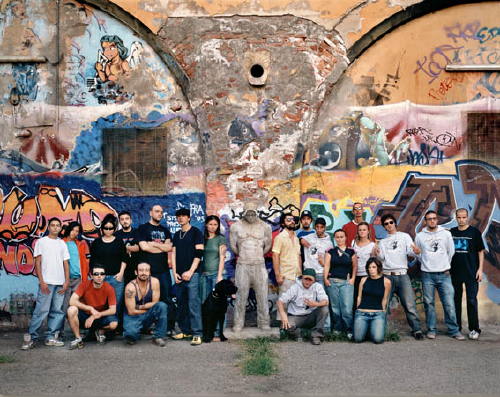
Tupac project in Bologna, 2005 by Paolo Chiasera
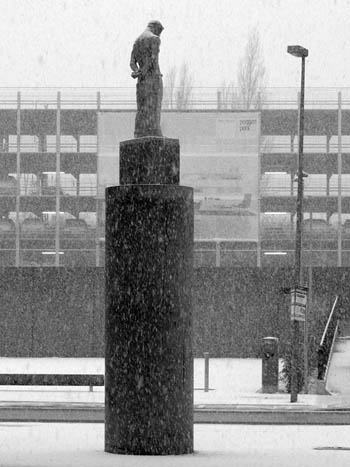
Tupac project in Herford, 2005 by Paolo Chiasera
After October 2000, following the change of regime in Serbia, Turbo-culture entered its own transitional phase. While war time Turbo-culture was mostly associated with exaggerated nationalism, almost pornographic kitsch and crime glorification, the post war Turbo-sculpture phenomenon boldly contrasts nationalist xenophobia while retaining its stylistic identity.
Recently, a Belgrade jury of artists and intellectuals appointed to commission a monument to the victims of the wars of the 1990s found they could not agree on whom to honor. Mileta Prodanović, a Serbian writer and painter who was on the committee, said the commission’s failure reflected the ideological vacuum left over from the time of Milosevic. “These Hollywood monuments are a subversive response [to the governments of that time], “which they are mocking,” he said. “People realize that many of our soldiers in the wars of the 1990s were criminals who stole, robbed and killed. So people are searching for alternative role models and this is a healthy rejection of nationalism,” stated Prodanović. But artist Milica Tomić, who also served on the jury, said she feared these new heroes imported from films and popular culture were just an excuse to avoid facing up to the bloody history of the Balkans. “This turning to Rocky or Tarzan is unhealthy and dangerous,” she said. “We need to find a way of representing our grief, our responsibility and our despair. Until we do that, Serbia cannot come to terms with the present and the future.”
After October 2000, following the change of regime in Serbia, Turbo-culture entered its own transitional phase. While war time Turbo-culture was mostly associated with exaggerated nationalism, almost pornographic kitsch and crime glorification, the post war Turbo-sculpture phenomenon boldly contrasts nationalist xenophobia while retaining its stylistic identity.
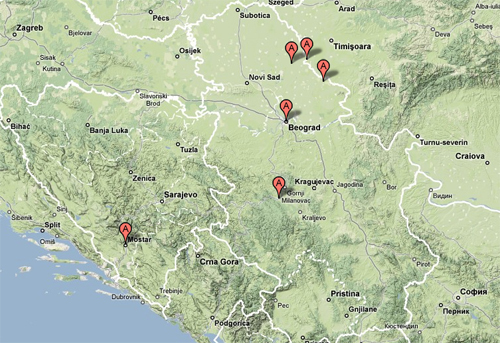
Statue locations on maps of Serbia and Bosnia and Herzegovina
Recently, a Belgrade jury of artists and intellectuals appointed to commission a monument to the victims of the wars of the 1990s found they could not agree on whom to honor. Mileta Prodanović, a Serbian writer and painter who was on the committee, said the commission’s failure reflected the ideological vacuum left over from the time of Milosevic. “These Hollywood monuments are a subversive response [to the governments of that time], which they are mocking,” he said. “People realize that many of our soldiers in the wars of the 1990s were criminals who stole, robbed and killed. So people are searching for alternative role models and this is a healthy rejection of nationalism,” stated Prodanović. But artist Milica Tomić, who also served on the jury, said she feared these new heroes imported from films and popular culture were just an excuse to avoid facing up to the bloody history of the Balkans. “This turning to Rocky or Tarzan is unhealthy and dangerous,” she said. “We need to find a way of representing our grief, our responsibility and our despair. Until we do that, Serbia cannot come to terms with the present and the future.”
There is also a diaspora of Yugoslav heroes making sculptural appearances in other parts of the World. Nikola Tesla, claimed by both Serbs and Croats, for example, is immortalized in Niagara Falls, the monument a gift of Yugoslavia to the United States in 1976.
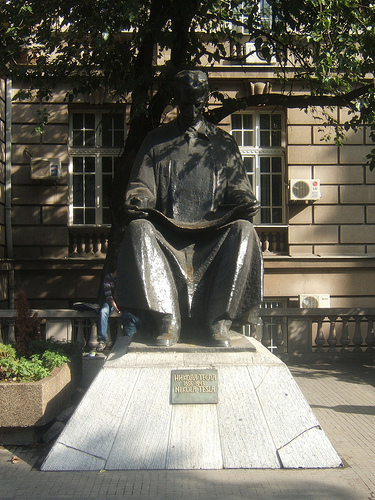
Nikola Tesla monument in Belgrade

Nikola Tesla on Goat Island in Niagara Falls
Dražen Petrović was a Croatian basketball player whose rising NBA career was tragically ended by his death in 1993. On April 29, 1995, a statue commemorating Petrović’s significance to the world of sports was erected in front of the Olympic Museum in Lausanne, Switzerland, thus making him only the second athlete to receive this honor. In 2006 another monument was uncovered in Zagreb in front of Dražen Petrović Memorial Center.
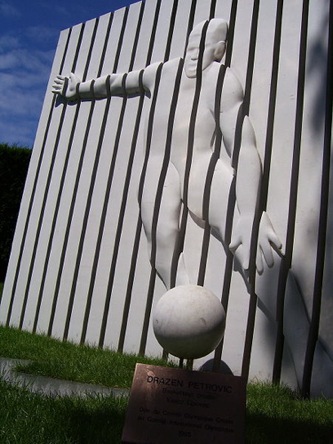
Dražen Petrović monument in Lausanne

Dražen Petrović monument in Zagreb

Tito in Mexico City
Tito’s inclusion in the Non-Aligned Movement (an international organization of states considering themselves not formally aligned with or against any major power bloc) led to numerous personal and group monuments outside of Yugoslavia.
Slovenian philosopher, Slavoj Žižek, claims that the well-known ecologists’ motto “think global, act local” has been reversed in US politics to “think local, act global.” As a counterweight to the non-ceasing import of western idols to the Balkans, it would do the West some good to reverse roles in cultural exchange by honoring heroes outside of their own geographic borders. Maybe statues to Milla Jovovich, Maxo Vanka, Vlade Divac, Dragutin Tadijanović and other great Yugoslav figures wouldn’t hurt.
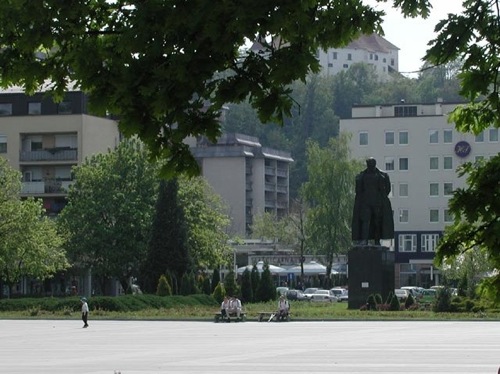
The largest statue of Tito in the world, in Velenje, Slovenia
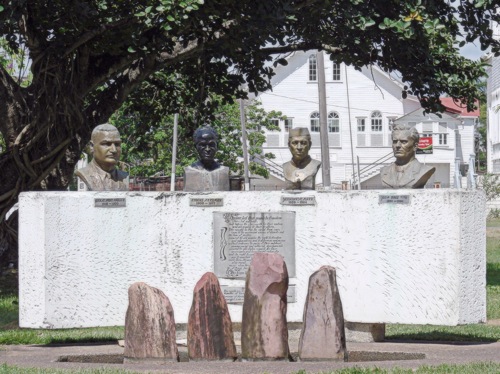
Non-Aligned monument in Guyana, Tito is on the right

Tito posing for a sculpture in his residence in Igalo, Montenegro


{ 15 comments }
I am interested in the ambivalence exhibited towards using Hollywood icons as substitutes for local (former) Yugoslav figures. On one hand it is a explicit refusal to recognize soldiers and partisans of the turmoil of the 90s as honourable figures, and Hollywood characters/caricatures index this exaggerated tendency towards hero worship and idolization. On the other hand, it can be interpreted as a display of juvenile ignorance of the distinction between real people with real struggles and sufferings from fictionalized representatives of optimism and idealism–in other words–a repression of traumatic truths for easy narratives and happy endings (Hollywood).
What concerns me is not the ‘either/or’ of both interpretations but the ‘both/and.’ While the intention and intellectualization of this phenomena lies with the conscious awareness of its parodic devices, the subversive element can all too easily be lost on the very people who need to come to terms with their (lack of) heroes and role models. The danger here is the ever widening gap between history and happy ending.
If Turbo-Culture also implies an accelerated rush towards newer and more progressive ideas of societal organization, let’s hope it doesn’t leave history in the dust, lost in the fog of Hollywood’s exhaust fumes.
I am interested in the ambivalence exhibited towards using Hollywood icons as substitutes for local (former) Yugoslav figures. On one hand it is a explicit refusal to recognize soldiers and partisans of the turmoil of the 90s as honourable figures, and Hollywood characters/caricatures index this exaggerated tendency towards hero worship and idolization. On the other hand, it can be interpreted as a display of juvenile ignorance of the distinction between real people with real struggles and sufferings from fictionalized representatives of optimism and idealism–in other words–a repression of traumatic truths for easy narratives and happy endings (Hollywood).
What concerns me is not the ‘either/or’ of both interpretations but the ‘both/and.’ While the intention and intellectualization of this phenomena lies with the conscious awareness of its parodic devices, the subversive element can all too easily be lost on the very people who need to come to terms with their (lack of) heroes and role models. The danger here is the ever widening gap between history and happy ending.
If Turbo-Culture also implies an accelerated rush towards newer and more progressive ideas of societal organization, let’s hope it doesn’t leave history in the dust, lost in the fog of Hollywood’s exhaust fumes.
I am interested in the ambivalence exhibited towards using Hollywood icons as substitutes for local (former) Yugoslav figures. On one hand it is a explicit refusal to recognize soldiers and partisans of the turmoil of the 90s as honourable figures, and Hollywood characters/caricatures index this exaggerated tendency towards hero worship and idolization. On the other hand, it can be interpreted as a display of juvenile ignorance of the distinction between real people with real struggles and sufferings from fictionalized representatives of optimism and idealism–in other words–a repression of traumatic truths for easy narratives and happy endings (Hollywood).
What concerns me is not the ‘either/or’ of both interpretations but the ‘both/and.’ While the intention and intellectualization of this phenomena lies with the conscious awareness of its parodic devices, the subversive element can all too easily be lost on the very people who need to come to terms with their (lack of) heroes and role models. The danger here is the ever widening gap between history and happy ending.
If Turbo-Culture also implies an accelerated rush towards newer and more progressive ideas of societal organization, let’s hope it doesn’t leave history in the dust, lost in the fog of Hollywood’s exhaust fumes.
A very interesting and informative essay with striking and well-documented examples. Within the essay, the artist Milica Tomic is cited, who desires that ways be found to represent the grief, the responsibility and despair of the 90s wars other than through these Hollywood idols or other artists not related to these wars, which may represent more the avoidance of facing up to history. I would be very interested in knowing how the various artists of VVork situate themselves with regard to this comment. Sandra
A very interesting and informative essay with striking and well-documented examples. Within the essay, the artist Milica Tomic is cited, who desires that ways be found to represent the grief, the responsibility and despair of the 90s wars other than through these Hollywood idols or other artists not related to these wars, which may represent more the avoidance of facing up to history. I would be very interested in knowing how the various artists of VVork situate themselves with regard to this comment. Sandra
A very interesting and informative essay with striking and well-documented examples. Within the essay, the artist Milica Tomic is cited, who desires that ways be found to represent the grief, the responsibility and despair of the 90s wars other than through these Hollywood idols or other artists not related to these wars, which may represent more the avoidance of facing up to history. I would be very interested in knowing how the various artists of VVork situate themselves with regard to this comment. Sandra
my next project will now be a large sculptural super-collider that will create fusion while sculpting animated copulations of a young Nikola Tesla and Milla Jovovich with hot plasma and light. Thanks VVORK.
my next project will now be a large sculptural super-collider that will create fusion while sculpting animated copulations of a young Nikola Tesla and Milla Jovovich with hot plasma and light. Thanks VVORK.
Great read, thanks.
Snapped this picture
http://www.flickr.com/photos/olofw/2257377117/
in a gallery in berlin feb 2k8. Looks like the exact same mold.
Great read, thanks.
Snapped this picture
http://www.flickr.com/photos/olofw/2257377117/
in a gallery in berlin feb 2k8. Looks like the exact same mold.
turbo ground zero
turbo ground zero
turbo ground zero
the Bruce Lee sculpture is a work by famous Croatian artist Ivan Fijolic http://fijolic.blogspot.com/. He made the golden statue in Mostar first, but after it was destroyed, he made a new pink plastic version from the same mold. the new version is placed on a rotating basis.
the Bruce Lee sculpture is a work by famous Croatian artist Ivan Fijolic http://fijolic.blogspot.com/. He made the golden statue in Mostar first, but after it was destroyed, he made a new pink plastic version from the same mold. the new version is placed on a rotating basis.
Comments on this entry are closed.
{ 2 trackbacks }